
Bell Aerosystem Air Cushion for Joint Surface Ships Program Office
The Bell Aerosystem air cushion vehicle design for the Joint Surface Effect Ships Program Office. At the time, the government was seeking for ways to extricate crude oil from northern Alaska and transport it to the US mainland for processing. There were several options available, a new larger, more powerful ice breaker, nuclear-powered submarine tankers, large aircraft tankers, and a pipeline. The former options included extremely large investments of money and time, while the latter posed significant environmental risks. Researchers developed another alternative—a 10,000-ton, chemically-powered aircushion tanker to carry oil from northern Alaska to a floating port where the oil would be transferred to tankers in deep unfrozen water. The air-cushion tanker could go over ice and land, while normal tanker ships impacted the ice and generally remained 30 miles offshore. The first air-cushion vehicle was developed in 1961. 168-ton vehicles had been used extensively in the English Channel since 1968, and 250-ton transporters began operation in Arctic in 1971. In the end, the Alaskan Pipeline was built in the mid-1970s utilizing a more robust infrastructure to help prevent environmental damage.
- X

























